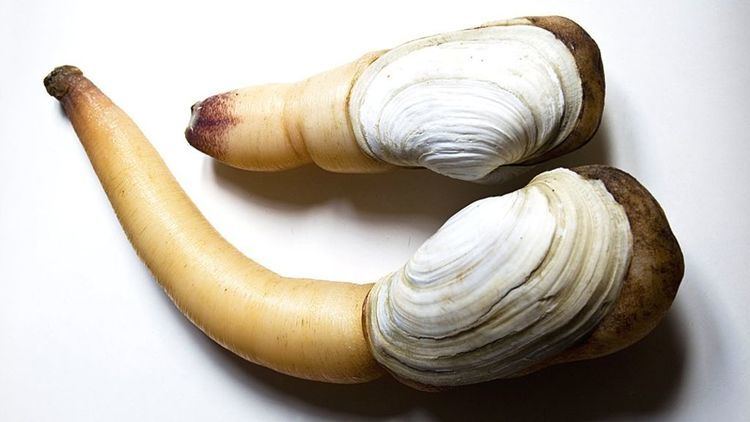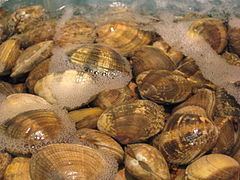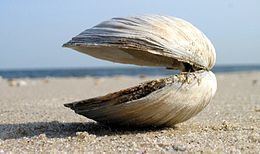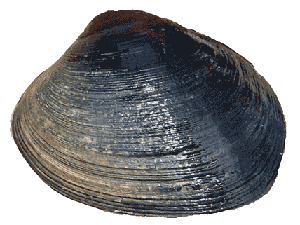Kingdom Animalia Class Bivalvia | Phylum Mollusca | |
Similar Oyster, Mussel, Scallop, Shrimp and prawn as food, Squid as food | ||
World s oldest animal 507 year old clam discovered and killed
Clam is a common name for several kinds of bivalve molluscs. The word is often applied only to those that live as infauna, spending most of their lives partially buried in the sand of the ocean floor. In particular, edible infaunal bivalves are often called clams. Clams have two shells of equal size connected by two adductor muscles and have a powerful burrowing foot. Clams in the culinary sense do not live attached to a substrate (like oysters and mussels) and do not live near the bottom (like scallops). In culinary usage, clams are commonly eaten marine bivalves, as in clam digging and the resulting soup, clam chowder. Many edible clams such as palourde clams are oval or triangular; however, razor clams have an elongated parallel-sided shell, suggesting an old-fashioned straight razor.
Contents
- World s oldest animal 507 year old clam discovered and killed
- My fresh water clam 12x speed
- Anatomy
- North America
- Japan
- Italy
- India
- Trinidad and Tobago
- Religion
- As currency
- Species
- References

Some clams have life cycles of only one year, while at least one may be over 500 years old. All clams have two calcareous shells or valves joined near a hinge with a flexible ligament, and all are filter feeders.

My fresh water clam 12x speed
Anatomy

A clam's shell consists of two (usually equal) valves, which are connected by a hinge joint and a ligament that can be external or internal. The ligament provides tension to bring the valves apart, while one or two adductor muscles can contract to close the valves. Clams also have kidneys, a heart, a mouth, a stomach, a nervous system and an anus. Many have a siphon.
North America
In culinary use, within the eastern coast of the United States, the term "clam" most often refers to the hard clam Mercenaria mercenaria. It may also refer to a few other common edible species, such as the soft-shell clam, Mya arenaria and the ocean quahog, Arctica islandica. Another species commercially exploited on the Atlantic Coast of the United States is the surf clam Spisula solidissima. Scallops are also used for food.

Clams can be eaten raw, steamed, boiled, baked or fried. They can also be made into clam chowder or they can be cooked using hot rocks and seaweed in a New England clam bake.
Japan

In Japan, clams are often an ingredient of mixed seafood dishes. They can also be made into hot pot, miso soup or Tsukudani. The more commonly used varieties of clams in Japanese cooking are the Shijimi (Corbicula japonica), the Asari (Venerupis philippinarum) and the Hamaguri (Meretrix lusoria).
Italy
In Italy, clams are often an ingredient of mixed seafood dishes or are eaten together with pasta. The more commonly used varieties of clams in Italian cooking are the Vongola (Venerupis decussata), the Cozza (Mytilus galloprovincialis) and the Tellina (Donax trunculus). Though Dattero di mare (Lithophaga lithophaga) was once eaten, overfishing drove it to the verge of extinction (it takes 15 to 35 years to reach adult size and could only be harvested by smashing the calcarean rocks that form its habitat) and the Italian government has declared it an endangered species since 1998 and its harvest and sale are forbidden.
India
Clams are eaten more in the coastal regions of India, especially in the Konkan, Kerala, Bengal and Karnataka regions.
In Kerala clams are used to make curries and fried with coconut. In Malabar region it is known as "elambakka" and in middle kerala it is known as "kakka". clams curry made with coconut is a rather delicious dish from malabar especially in Telicherry region. In the south western coast of India, also known as the Konkan region in the state of Maharashtra, clams are used to cook curries and side dishes, like Tisaryachi Ekshipi, which is clams with one shell on. Beary Muslim households in the Mangalore region prepare a main dish with clams called Kowldo Pinde. Kowl is "clams" in the local language, and Pinde is "rice ball".
Trinidad and Tobago
Clams and shellfish are locally called "chipchip", and local fishermen sell them in rural markets.
Religion
The Moche people of ancient Peru worshiped the sea and its animals. They often depicted clams in their art.
In Judaism, clams are considered non-kosher (treif) along with all other shellfish.
As currency
Some species of clams, particularly Mercenaria mercenaria, were in the past used by the Algonquians of Eastern North America to manufacture wampum, a type of shell money.
Species
Edible:
Not usually considered edible:
